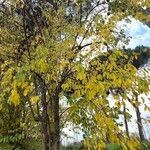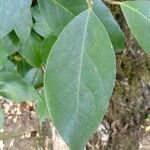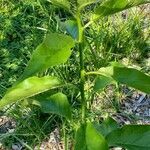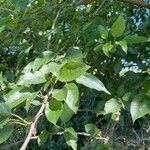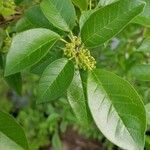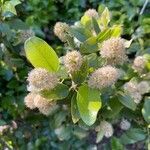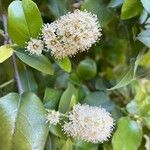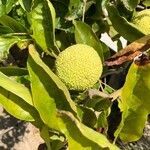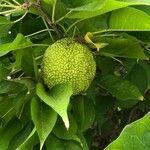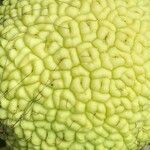A small tree which loses its leaves. The crown is round. It can grow 10-15 m high. The plant has a thick white sap. The bark is orange-brown and cracked. The leaves are small and alternate. They are oval and 7-12 cm long by 5 cm across. They narrow into a long tip. The twigs are orange brown. They can become a thorn at each leaf base. The flowers are wind pollinated. The male and female flowers are on separate trees. They are small and yellow in clusters 1 cm long. The fruit are 10-14 cm across. They resemble a green orange made up of small fruit fused together.
Tall shrub or tree to 12 m or more high; spines 1–5 cm long, stout; latex milky, sticky, largely confined to fruits. Leaves: lamina ovate, 4–15 cm long, 2–6 cm wide, acuminate at apex, paler below; petiole 15–30 mm long; stipules 1.5–2 mm long. Male inflorescence cylindrical or globose, 15–25 mm diam., pedicels 2–10 mm long; peduncle 10–20 mm long. Syncarp ± globose, (7–) 10–15 cm diam., surface irregular, yellow-green to green, exuding cream-coloured sap when cut. Seeds cream-coloured, deeply embedded in receptacle.
Spinous, deciduous tree to 20 m high. Lvs ovate, acute to acuminate, obtuse to truncate at base, entire, glabrous to moderately hairy above, scarcely to moderately hairy below, 5-12 cm long; young lvs densely hairy. Petiole < blade. Spines stout, 0.5-2 cm long. Stipules 2 per node, lanceolate, hairy. Infls globose to ± elongated. Fls greenish; ♂ fls with anthers inflexed in bud. Syncarp rough, orange, subglobose, 7-14 cm diam. Achene ellipsoid, c. 7 mm long.
Tree to 20 m; lvs lance-ovate, 6–12 cm, acuminate, petiolate; thorns stout, 1–2 cm; fr yellowish-green, 6–12 cm thick, the surface convoluted. Rich, moist soil; Ark., Okla., and Tex., occasionally adventive or persistent after cult. with us. May, June. (Toxylon p.)
